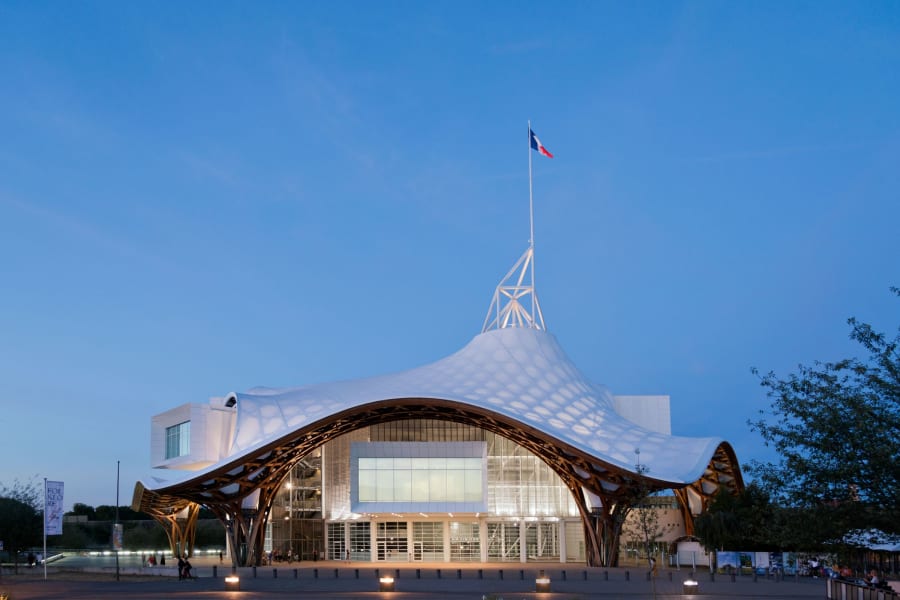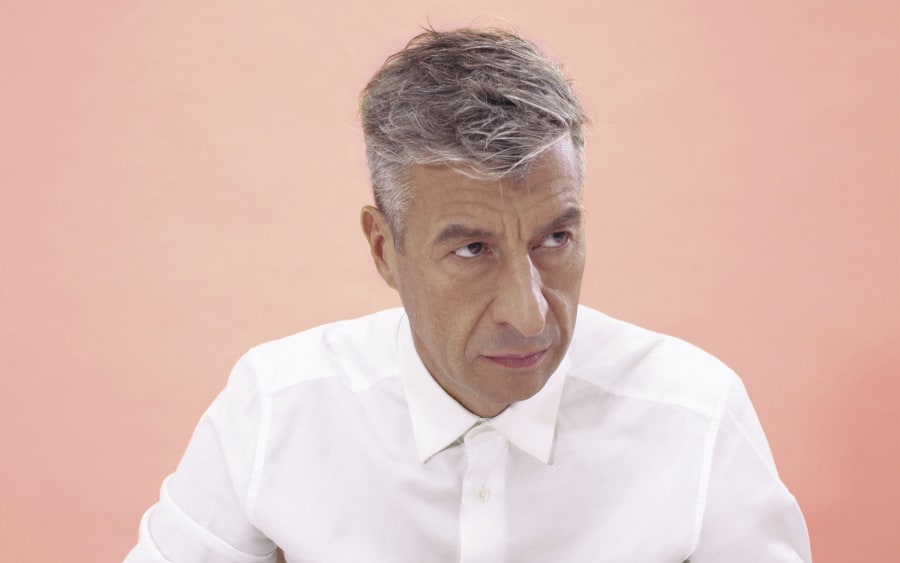在藝術界,有些合作關係早已超越了職業層面的協作,進入攜手實現共同願景的創作狀態,從而創造出遠超預期的成果。正如佛烈.雅士提(Fred Astaire)與珍姐.羅渣士(Ginger Rogers)、卜.科西(Bob Fosse)與麗莎.明妮莉(Liza Minnelli)等傳奇組合一樣,自由不羈的藝術家毛里吉奧.卡特蘭(Maurizio Cattelan)與策展人兼博物館館長齊亞拉.芭利希(Chiara Parisi)之間,也催生出罕見的創意性化學反應,不斷突破藝術的邊界。
兩人的初次相遇是籠罩在神秘的光環中。藝術家仍記得這樣的畫面:「1990年代中期,在麥地奇別墅(Villa Medici)的花園裡,一個如幻影般的白色身影,優雅含笑。」而在芭利希的記憶裡,這場初遇卻呈現另一番景象:「那是1990年代的米蘭,在一場並非她主辦的展覽開幕式上,人們早已對她議論紛紛,現場瀰漫著緊繃氛圍。這時毛里吉奧出現了,帶著一種奇特的、近乎令人卸下心防的從容——唯有具備深刻同理心之人方能擁有這般氣質。」
記憶的碎片如迷人的拼圖般交織。「我真正與他交談是在羅馬。我原以為他會像拉斐爾那般,令人難以捉摸。」她續道,「他當時在找游泳池,但毛巾已經掛在脖子上。我心想,這人肯定是個樂觀主義者。」然後腦海浮現出一個曾經先知先覺的畫面:「某天傍晚,我和加百列.奧羅斯科(Gabriel Orozco)開著我的雷諾4號,從聖三一教堂(Trinità dei Monti)駛往阿文提諾山(Aventine Hill)。毛里吉奧已經在那裡了。他顯得有些疏離,帶著微微的戒備。我分不清是因為周遭的人還是那些廢墟。他看起來如此純真,當時我就想,總有一天,他的作品必須能夠保護他。」
芭利希的博物館生涯始於2004年,當時她出任法國中部利穆贊地區的瓦希維耶爾島國際藝術與景觀中心(Centre international d'art et du paysage de Vassivière)總監。2011年,她更在法國文化界奠定重要地位,主掌巴黎鑄幣廠(Monnaie de Paris)的藝術策劃,為這座承載五百年歷史的建築注入新生命。2014年保羅.麥卡錫(Paul McCarthy)的《巧克力工廠》(Chocolate Factory)便是明證——這項與芳登廣場(Place Vendôme)上巨型雕塑《樹》(Tree)同步展出的計劃,以激進大膽的姿態永載藝術史冊。而卡特蘭則以非典型自學之路,在藝術界經典軌跡之外開闢蹊徑。1990至2000年代,他憑藉《第九時辰》(La Nona Ora,1999)——被隕石擊中的教宗若望保祿二世,以及《他》(Him,2001)——跪地禱告的希特拉像等重要作品,奠定了國際聲譽。
他們的初次相遇,開啟了一場偉大的藝術冒險。誰也未曾料到,2017年芭利希會邀請卡特蘭到巴黎鑄幣廠舉辦展覽「Not Afraid of Love」——這場展覽後來被視為其職業生涯中的里程碑之作。早在2011年,卡特蘭曾在紐約古根漢美術館(Solomon R. Guggenheim Museum)舉辦回顧展,並在展覽期間正式宣佈退休。在那場展覽中,他將所有作品懸掛在圓形大廳的穹頂之下,以一種令人眩暈的隱喻象徵著永遠自由漂浮的藝術世界。而巴黎的這場展覽,標誌著他出人意料地重返博物館。
「與毛里吉奧合作,就像跳一支探戈,起初重心不斷變化,而慢慢地,你會在信任與不可預測性之間找到平衡。通過無數次的對話、幽默的諷刺與真誠的傾聽,我們逐漸達成默契。」芭利希坦言。
自2019年起,芭利希坦出任龐畢度中心梅茲分館(Centre Pompidou-Metz,下稱梅茲龐畢度)館長,並定期邀請卡特蘭造訪。「我們立刻就能理解對方:她有著火山般的能量,而我則總是慢半拍,卻隨時準備著與新想法不期而遇。我們經常打很長的電話,像是頭腦風暴,也像是心理治療:想法、疑慮、頓悟和懺悔不斷湧現。我們就像一對走調的樂器,努力在混亂中合奏出一種和諧的不協和音。」卡特蘭如此形容二人之間的創作狀態。
2024年,他們的合作迎來了出人意料的表達出口。梵蒂岡將其參加威尼斯雙年展展館的藝術指導任務,委託芭利希與布魯諾.拉辛(Bruno Racine)共同擔任——後者是格拉西宮-海關大樓美術館(Palazzo Grassi-Punta della Dogana)的館長。展館位於朱代卡島上曾經的Santa Maddalena delle Convertite教堂,如今這裡是一座女子監獄。芭利希毫不猶豫地邀請卡特蘭展出其作品《父親》(Father),這幅巨型壁畫描繪了他的雙足,懸掛於教堂立面,直面「超越性」的主題。芭利希回憶道:「我非常清楚,這個項目的根基既脆弱又強大。我們選擇在邊緣試探,迴避確定性,為懷疑留出空間。這對我而言,也是一種個人挑戰:去思考一個歷史如此厚重的地方,如何能夠向更開放、更人性化的敘事敞開。」
他們的最新策展項目「Dimanche Sans Fin. Maurizio Cattelan et la Collection du Centre Pompidou」計劃在梅茲龐畢度展出至2027年2月2日,進一步拓展博物館體驗的邊界。為慶祝梅茲龐畢度成立15周年,展覽匯聚了400多件龐畢度中心(Centre Pompidou)的館藏作品,與卡特蘭的標誌性作品展開對話。展覽以字母表為結構,呈獻26個主題單元。其中展出的亮點包括卡特蘭的經典之作《L.O.V.E.》(2010),這座巨型手部雕塑,只有中指高高豎起,其餘四指全部被截斷;《Felix》(2001),呈現一具巨大的貓骨架;以及備受爭議的《喜劇演員》(Comedian,2019),一根用膠帶黏在牆上的香蕉。這些作品與歷史名作相互呼應,例如索妮亞.德洛內(Sonia Delaunay)的《Le Bal Bullier》(1913)以及安德烈.布勒東(André Breton)的《Studio Wall》,後者是首次在巴黎以外展出。
芭利希表示:「我想要一場讓人沉浸其中、無法匆匆而過的展覽,讓人棲居其中。我想要一場令人一見傾心的展覽,不提供簡單的答案,而是充滿開放性的問題。」卡特蘭則強調展覽項目的私密性:「我希望它能在每個參觀者身上留下某種印記——就像在海灘上度過一天後留在身上的沙粒——雖然有點惱人,卻提醒著你:你曾置身於一個時間凝滯的地方。我希望觀展之後,人們會有一種『懸浮』之感,就像那些看似平淡無奇的周日下午,什麼都沒發生,但你卻隱約感覺,一切都有可能改變。」
這對搭檔的抱負遠不止於展覽。他們在梅茲龐畢度的「School without Roof or Walls」項目,旨在打造一個實驗性的教育實驗室,重新思考藝術教育的可能性。該項目於2024-2025學年啟動,卡特蘭擔任特別導師,首批畢業生已經正式結業。這所學校面向中學生,教授美學、生物學、詩學和形而上學等多門學科。然而,對於卡特蘭來說,學校曾是「無盡的折磨,只有星期天才能喘口氣」。當被問及為何要在博物館內創辦學校時,芭利希解釋說:「學習永遠不應脫離生活。博物館並非神殿,而是一個鮮活的生命體,學校則是它的脈搏。把學校設在博物館內,是對文化只能在沉默中被凝視的觀念的挑戰。這種教學方式既是一種政治姿態,也是一種詩意表達:將想像的空間還給下一代,在藝術中,一切皆可被重新思考。」
通過他們的項目全貌,人們得以洞察這一藝術組合的非凡活力。芭利希和卡特蘭憑藉其百科全書般的藝術史知識,毫不猶豫地打破傳統體制的框架。他們是公認的自由靈魂,對文化機制有著深刻的理解。二人總結道:「博物館常被看作是紀念與靜默的空間,但我們堅信,它不該成為僅僅緬懷過往的陵墓。我們更願將博物館視為記憶與生活交織的場所,讓當下持續喚醒過去。當水面平靜得只剩天空的倒影時,藝術就是擾亂水面的一陣漣漪。」
毛里吉奧.卡特蘭由高古軒(Gagosian,紐約、巴塞爾、倫敦、香港、巴黎、羅馬)、MDC畫廊(Massimodecarlo,米蘭、香港、倫敦、巴黎)、貝浩登(Perrotin,巴黎、香港、倫敦、洛杉磯、紐約、首爾、 上海、東京)和瑪麗安.古德曼畫廊(Marian Goodman Gallery,紐約、洛杉磯、巴黎)代理。
「Dimanche Sans Fin. Maurizio Cattelan et la collection du Centre Pompidou」
龐畢度中心梅茲分館
展期至2027年2月2日
本文作者Patrick Steffen是巴塞爾藝術展法國高級編輯,常駐巴黎。
頁頂圖片標題:2025年,毛里吉奧.卡特蘭在梅茲,照片由Louis Canadas為巴塞爾藝術展拍攝
2025年5月14日發佈


